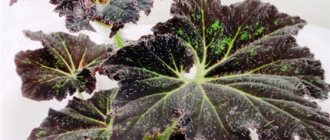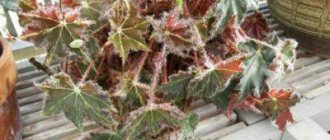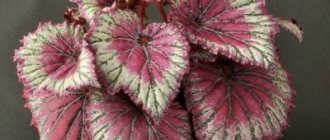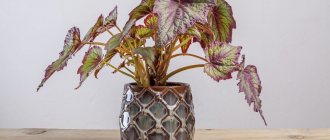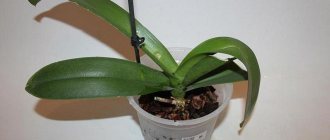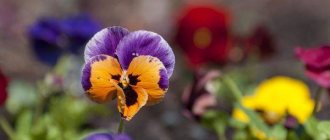Begonia - “Napoleon's Ear” or guardian of family happiness
Begonia, one of the old and good friends of many indoor plant lovers, came to our house again and fit perfectly into the modern interior.
The variety of representatives of this genus is amazing: magnificent, beautifully flowering and striking varieties of shapes, colors, textures and sizes of decorative foliage. Just think: 800 species of these amazing plants live on our windowsills and more than 2000 forms bloom in gardens around the world. Large and miniature, glossy and pubescent, green, silver and multi-colored - these are the numerous species and varieties of these herbaceous plants native to the tropical and subtropical forests of Asia, Africa and America.
Among decorative deciduous plants, castor begonia is the most common. This is a powerful plant with a thickened, heavily pubescent, recumbent stem. Its leaves are large, coarsely toothed along the edges, bronze-green above, reddish below, with protruding veins on long thick pubescent petioles. Begonia Bauer "Tiger", on the contrary, is small in size, compact in shape and can be used to create bottle gardens.
When you look at the Mason begonia, at its amazingly beautiful light green leaves with a dark brown cross-shaped pattern in the center, you really begin to believe the assertion of some experts that begonia absorbs the energy of family quarrels and scandals. No less interesting is the Olympic variety of royal begonia: its silvery leaf curls towards the center, resembling a snail.
And if the appearance of begonias is very diverse, then caring for them is approximately the same. Most of these plants are inhabitants of the ever-humid tropical forests, so they require diffused light. The best place in the apartment for them would be the window sill of an eastern or northern window (the temperature in winter should not fall below 16 degrees).
Begonias have a succulent lodging stem, so it is better to use wide and shallow pots for planting. For better water flow it is necessary to make drainage. The soil mixture for planting them should be light and nutritious. Usually it is prepared from a mixture of leaf soil, humus, peat with a small addition of sand.
In summer, plants are watered abundantly, thoroughly soaking the entire lump. Try not to allow water to stagnate in the pan: after watering, it can remain there for no more than 20 minutes. In winter, plants are watered as the soil ball dries out. You have to be careful here: drying, but not drying out. When the leaves of the plant dry out, they sag and do not return to their original state (this is especially true for the Olympic variety or “snail”, as it is popularly called). During the heating season, take care of air humidification. Moreover, it is not advisable to spray begonias with pubescent leaves; it is better to place pots with plants on pallets with damp expanded clay or moss.
Begonia is fed only in the summer, 2 times a month, alternating organic and mineral fertilizers.
Begonia reproduces by its leaves, or, as botanists say, by vegetative means. It's better to do this in the spring. Place the cut begonia leaf on a damp substrate so that the veins of the leaf touch the ground. Cover the sheet with a glass cap (or a jar) and leave it in the light in a warm place. The cap must be lifted every day to ventilate the “mother in labor.” And now, in about twenty days, the first young shoots of new plants will appear from the petiole or from cracks in the leaf.
When talking about begonia, I cannot keep silent about tuberous begonia. As a houseplant, it is seasonal and has a dormant period, but for two to three months the begonia blooms with such beautiful double flowers of white, yellow, red, orange, cream and burgundy that it is worth getting this beauty. Tubers in a pot are kept in a cool room or in a cool, dry place until spring, and then replanted, watered and exposed to light.
A little history. Begonias were first discovered and described by the French monk C. Plushier during an expedition to the island of Haiti. And the plant was named after the great lover and collector of flowers, the governor of San Domingo, Michel Begon, who lived in the 17th century. There is also a Russian name for this plant: “Napoleon’s Ear.” That's what it was called in 1812 during the flight of the French from Moscow. And indeed, the contours on the lower red side of the begonia leaf look like a large frostbitten ear.
Begonia bear's ear. What kind of indoor flower is this?
There are about 1000 natural species in the begonia genus, from which more than 2000 hybrids have been obtained. The country of origin is considered to be West Africa, from where begonia spread to South America (as far as Mexico), Southeast Asia and Indochina. Accordingly, tropical and subtropical climates are native to begonias.
According to the scientific classification, there are three centers of distribution of begonia:
- Central African.
- Brazilian (Amazon basin).
- Southeast Asian (Indonesia, Malaysia, Indochina).
The genus Begonia is named after the governor of Haiti, Michel Begon, who lived from 1638 to 1710. In 1687, Michel Begon organized a plant-collecting expedition to the Antilles in the West Indies (between North and South America). The expedition was accompanied by a friend of the governor, the famous French botanist monk Charles Plumier.
During the expedition, six species of a plant were discovered, named by C. Plumier begonia after his friend and expedition organizer Michel Begon. Begonia came to Russia under Peter I in 1717 from Holland along with other tropical plants. Intensified selection and hybridization of begonia species began only in the second half of the 19th century, after the discovery of tuberous large-flowered begonias in the Andes, Peru and Bolivia in 1864–1866.
The largest number of hybrids were bred in Belgium from tuberous begonias. Begonias are annual and perennial, growing as herbs, shrubs or subshrubs. Shrubs often have erect stems, occasionally climbing. Subshrubs with creeping rhizomes or tuberous-thickened rhizomes, sometimes with a tuber. Tuberous begonias, by the way, can be planted in the garden, the rest only indoors.
Please note that tuberous begonias have very fragile stems.
The leaves of all types of begonia are asymmetrical, rounded or with a serrated edge. The colors of the leaves are very diverse: from monochromatic (in various shades of green) to 4-colored, which combine shades of silver-white, green, burgundy and brown. Flowers in warm colors: white, beige, yellow, orange, red. The sepals of the flowers are unequal and brightly colored.
Fruit box. They reproduce by seeds, cuttings, leaves (fragments), shoots from adventitious buds, and division of the tuber.
Who are houseplants?
The desire to surround oneself with plants has lived in people from time immemorial. The first who began to grow indoor plants were the Egyptians, who began this work more than 3 thousand years ago. They decorated their houses inside and out with bushes, dwarf trees and bindweed. The most advanced civilizations in Europe were the Romans and Greeks, who especially valued nature and beauty. For them, indoor plants became an attribute of well-being and wealth. Pots of flowers appeared in the courtyards.
However, the changeable climate did not allow them to keep flowers outside for a whole year. And then botanical gardens and greenhouses gradually began to appear. Rich people from the northern countries also wanted to have their own greenhouses and began adding winter gardens to their houses.
Over time, when people began to conquer other countries and continents, a fashion arose to breed foreign plants. Many of them died during transportation and did not reach their destination.
Nathaniel Ward, an English doctor, was not at all interested in plants, he was fascinated by butterflies. He took a jar, poured soil into it and walked through the gardens and fields, collecting caterpillars for pupation. He lost one of these jars for several months, and when Wardom found it, he saw that a small fern had grown inside. It was cozy and warm for this plant to grow, because moisture evaporated from the ground and then settled on the walls of the jar, and when it cooled, it flowed back into the jar.
It was thanks to Ward that the container was invented, which was later used for transporting plants.
The plant trade took off very quickly. Plantations began to appear, flower shops began to appear, different types of plants were crossed. So, for example, one pharmacist began to grow cacti in his window for his own pleasure. Others liked this idea so much that pots of flowers began to appear on every window. So flower delivery in Kharkov is cheap and you can take advantage of it.
But let’s figure out what and who is growing on our window.
Description of the plant
Indoor begonias are incredibly attractive plants. The plant uses a powerful creeping rhizome as its root system. The stem part is fleshy, small in size, covered with reddish-colored bristles.
The foliage is quite large, asymmetrical, and pointed. Leaves with serrated edges are located on oblong petioles. The leaf blade has a very bright and attractive color. Most often, green color predominates in coloring, as well as inclusions of scarlet, crimson, lilac, violet and even silver. Characteristic is the contrasting highlighting of veins.
The bright coloring and roughness of the foliage helps to increase the temperature on the surface of the leaf plate, which helps evaporate a significant amount of moisture. Thus, the root system receives sufficient nutrition and allows the culture to actively develop. Asymmetrically located leaves allow the ornamental crop to improve the uniform distribution of sunlight. The flowers are pink, not decorative enough, up to one centimeter in diameter. The plant blooms for a relatively short time, after which seed material is formed in small fruits.
Royal begonia: home care technology
Decorative indoor culture must be provided with high-quality and proper care, which includes the creation of a comfortable microclimate, as well as compliance with the irrigation regime and timely application of fertilizers.
Photo gallery
Optimal growing conditions
Royal begonias need very good lighting and diffused sunlight on the foliage . However, it is necessary to shade the decorative perennial from the scorching rays of the midday sun, and it is best to place flower pots with the plant on windows in an eastern or western direction.
Rex begonias do not tolerate heat well, so the temperature in summer should be 24-26°C during the daytime and 18-20°C at night. Average daily temperature fluctuations should not exceed 5-6°C. In winter, royal begonias should be kept at a temperature of 16-18°C. Optimal air humidity should not be higher than 45-50%.
Pot and soil for an indoor flower
A begonia flower pot must have good drainage holes. Before planting or replanting, you need to fill in the drainage layer, after which the planting container is filled with nutritious ready-made soil for growing Uzambara violets. It is allowed to use self-prepared nutrient soil mixtures based on:
- two parts of leaf soil, part of peat soil and part of coarse river sand;
- two parts of peat soil, part of coconut substrate, part of coarse river sand and part of pine bark;
- two parts universal soil mixture, part vermiculite, part river sand and part crushed pine bark.
Watering and fertilizing
Irrigation activities are carried out with settled, filtered water at room temperature as the soil dries out. Indoor species prefer nitrogen fertilizers that stimulate foliage growth processes. Complexes for feeding decorative flowering varieties need to be applied a couple of times a month after the start of flowering.
At the dormant stage, the perennial is fed no more than once a month. During the phase of ovary formation, fertilizing is carried out with phosphorus-potassium fertilizers. The use of the preparations “Bud”, “Ovary” and “Tsveten” gives very good results.
Timing and technology of replanting royal begonia
You can replant an ornamental plant as needed, after about a year, following the following recommendations:
- transplantation is carried out in the spring;
- the dimensions of the new planting container should be slightly larger than the previous flower pot;
- After removing the root system, a visual assessment of the condition of the root should be carried out, and, if necessary, damaged areas should be removed.
After replanting, it is necessary to water the royal begonia quite generously and install it in a window, using light shading in the first week. The first feeding should be carried out no earlier than a couple of weeks after replanting, which will allow the root system to strengthen in the new growing conditions.
Reproduction
Spring is the best time to propagate royal begonias. There are several methods for propagating decorative foliage crops, which are widely used in indoor floriculture:
- rooting of prepared cuttings with several well-developed and healthy leaves;
- bush division into several parts, each of which has a fairly developed root system and above-ground part;
- tuberous division by cutting into several parts, each of which has a sprout;
- leaves, on which cuts are made on the large veins on the reverse side, after which the planting material is immersed with cuts into well-moistened and clean sand.
Somewhat less commonly, seed propagation of royal begonia is used at home, in which the seedling material obtained from the sown seeds is planted in a permanent place in the spring.
Rules of care
As befits all beauties, begonia is quite capricious. However, even beginners can grow it if they know the basic requirements of the plant. The website flowery-blog.ru will tell you about this.
Temperature and lighting
Diffused light is a prerequisite for full growth and proper formation of a flower. Without any light at all, it stretches out and loses its decorative effect, and direct rays can burn delicate leaves! To ensure that indoor begonia blooms and grows spectacular foliage, place the pot on a south-eastern window, where there is no active sunlight until noon, but there is enough light all day long. Artificial light lamps will help compensate for the lack of lighting.
Regarding the temperature regime, it is also important to maintain the golden mean. In the cold, fungal diseases easily develop and the root system weakens. For most species, temperatures below 15 degrees are critical. But heat also has a bad effect on the appearance of the plant; it is best to keep it in the temperature range of 20-22 degrees, without sudden changes.
Watering and humidity
The begonia flower loves balance in everything, especially in watering. To prevent the soil from turning sour and drying out, focus on the condition of the top layer of the substrate. If the soil sticks to your fingers, you should postpone watering; if it has dried to a depth of 2-3 cm, then it’s time to water the plant. In spring and summer, begosha, as a rule, actively grows and blooms, accordingly, it requires more water. If growth has stopped, watering is reduced. 8 rules of watering.
✿
How and under what conditions does pig's ear bloom?
Flowering time and its duration depend on the species characteristics of such an ornamental perennial as indoor begonia. Royal begonias belong to a group of rhizomatous varieties that are grown for their colorful and very decorative foliage.
This species does not bloom too often in indoor floriculture, and the resulting flowers can hardly be called attractive. Royal begonia blooms with inconspicuous flowers of a delicate pinkish hue. As a rule, experienced flower growers prefer to cut off flower stalks if it is not intended to obtain and use seed material for breeding purposes and for propagating a perennial crop.
Flowers-pig ears at home and in the garden by 2022 Pigs
According to the Chinese calendar, 2022 will be under the sign of the Boar or Pig. He promises us happiness, because if the Dog is faithful, the Monkey is smart, and the Snake is wise, then the Pig, according to ancient eastern wisdom, is considered happy. We can only open our hearts to changes for the better and adequately meet the mistress of the year - with the flowers that are associated with her and are popularly known as “pig ears.”
Protection from diseases and pests
Subject to the rules of care and technology for growing decorative deciduous crops, indoor royal begonia is not too often affected by pests or pathogenic microflora:
- insufficient soil moisture can cause changes in the condition of the foliage, with the leaves acquiring an unhealthy appearance and brown tips;
- too pale coloring of the leaves may indicate insufficient lighting of the plant;
- infection by powdery mildew is accompanied by the appearance of a characteristic white powdery coating on the leaves and stem parts, to remove which modern antifungal chemicals are used;
- if the above-ground part of the plant is affected by gray mold or monilial burn, all affected areas should be removed, followed by treatment with 1% Bordeaux mixture. Repeated treatment with fungicides should be carried out approximately a month after the first spraying;
- If aphids, nematodes or spider mites are found on a plant, then in addition to the mechanical method of removing plant parasites, spraying with insecticides of plant origin or chemicals is carried out.
Begonia - “Napoleon's Ear” or guardian of family happiness
Begonia, one of the old and good friends of many indoor plant lovers, came to our house again and fit perfectly into the modern interior.
The diversity of representatives of this genus is amazing: magnificent, beautifully flowering and striking varieties of shapes, colors, textures and sizes of decorative foliage. Just think: 800 species of these amazing plants live on our windowsills and more than 2000 forms bloom in gardens around the world. Large and miniature, glossy and pubescent, green, silver and multi-colored - these are the numerous species and varieties of these herbaceous plants native to the tropical and subtropical forests of Asia, Africa and America.
Among decorative deciduous plants, castor begonia is the most common. This is a powerful plant with a thickened, heavily pubescent, recumbent stem. Its leaves are large, coarsely toothed along the edges, bronze-green above, reddish below, with protruding veins on long thick pubescent petioles. Begonia Bauer "Tiger", on the contrary, is small in size, compact in shape and can be used to create bottle gardens.
When you look at the Mason begonia, at its amazingly beautiful light green leaves with a dark brown cross-shaped pattern in the center, you really begin to believe the assertion of some experts that begonia absorbs the energy of family quarrels and scandals. No less interesting is the Olympic variety of royal begonia: its silvery leaf curls towards the center, resembling a snail.
And if the appearance of begonias is very diverse, then caring for them is approximately the same. Most of these plants are inhabitants of the ever-humid tropical forests, so they require diffused light. The best place in the apartment for them would be the window sill of an eastern or northern window (the temperature in winter should not fall below 16 degrees).
Begonias have a succulent lodging stem, so it is better to use wide and shallow pots for planting. For better water flow it is necessary to make drainage. The soil mixture for planting them should be light and nutritious. Usually it is prepared from a mixture of leaf soil, humus, peat with a small addition of sand.
In summer, plants are watered abundantly, thoroughly soaking the entire lump. Try not to allow water to stagnate in the pan: after watering, it can remain there for no more than 20 minutes. In winter, plants are watered as the soil ball dries out. You have to be careful here: drying, but not drying out. When the leaves of the plant dry out, they sag and do not return to their original state (this is especially true for the Olympic variety or “snail”, as it is popularly called). During the heating season, take care of air humidification. Moreover, it is not advisable to spray begonias with pubescent leaves; it is better to place pots with plants on pallets with damp expanded clay or moss.
Begonia is fed only in the summer, 2 times a month, alternating organic and mineral fertilizers.
Begonia reproduces by its leaves, or, as botanists say, by vegetative means. It's better to do this in the spring. Place the cut begonia leaf on a damp substrate so that the veins of the leaf touch the ground. Cover the sheet with a glass cap (or a jar) and leave it in the light in a warm place. The cap must be lifted every day to ventilate the “mother in labor.” And now, in about twenty days, the first young shoots of new plants will appear from the petiole or from cracks in the leaf.
When talking about begonia, I cannot keep silent about tuberous begonia. As a houseplant, it is seasonal and has a dormant period, but for two to three months the begonia blooms with such beautiful double flowers of white, yellow, red, orange, cream and burgundy that it is worth getting this beauty. Tubers in a pot are kept in a cool room or in a cool, dry place until spring, and then replanted, watered and exposed to light.
A little history. Begonias were first discovered and described by the French monk C. Plushier during an expedition to the island of Haiti. And the plant was named after the great lover and collector of flowers, the governor of San Domingo, Michel Begon, who lived in the 17th century. There is also a Russian name for this plant: “Napoleon’s Ear.” That's what it was called in 1812 during the flight of the French from Moscow. And indeed, the contours on the lower red side of the begonia leaf look like a large frostbitten ear.
Pig's ear flower. Beautiful begonia
There are a huge number of begonia varieties in the world.
Some of them amaze with their beautiful flowering, while others decorate with their leaves. There are even species adapted to open ground. Begonia is popularly called Napoleon's ear.
These plants are widespread in tropical rainforests and mountains.
The largest concentration of begonias is South America. This plant can also be found in the mountainous regions of India, the Eastern Himalayas, and on the island of Sri Lanka.
Requirements for cultivation and care
The soil should be 1 part sand, peat, humus and 2-3 parts leaf soil.
It is better to provide light lighting, but without direct sunlight.
In summer you need to water begonias abundantly, reduce the intensity in winter and autumn.
From spring to autumn, feed this plant with liquid fertilizer every 2 weeks.
Trim the stems after flowering.
It needs to be replanted in the spring.
Begonia propagates by cuttings or tubers.
Care
Begonias are unpretentious plants, they are resistant to disease, but they need to be properly cared for. The first is air humidity. They all need high humidity, so spray your plant regularly. You can also place a flower pot on a tray with water, but so that the pot is not in the water. Alternatively, you can place pebbles under the pot.
Among other things, begonia care includes maintaining temperature conditions. In summer about +20 degrees, in winter about 15, but not lower.
In winter, the plant must be placed in a bright place in the morning and evening for several hours.
Keep the soil moist but not wet. In spring and summer, the ideal option is to water as the earthen ball dries out; in winter, watering should be reduced.
It would be advisable to feed the begonia with full mineral fertilizers at least twice during the growth period. To improve flowering, remove female branches at the very beginning of growth.
Reproduction
Almost all types of begonias are propagated using stem or leaf cuttings, as well as by dividing the bush. Tuberous species can be propagated by tubers. With this propagation, the tubers are dug up after flowering and the stems are cut off. Afterwards, the material is placed in sand or peat for storage at a temperature of +9 degrees.
Tubers need to be planted from February to May. They are planted in small pots with sandy soil and only deepened halfway.
Seed propagation is a very difficult matter and quite troublesome.
Diseases and pests
It may happen that the begonia has begun to shed leaves or buds. The most likely reason for this is a lack of moisture in the soil and air humidity.
Pale leaf color is the main sign of insufficient lighting.
If you keep the plant in an environment that is too humid and at low temperatures, gray rot may form. This fungal disease can only be combated by removing the affected parts and then treating the cuts with a fungicide.
The most common pests of begonias are spider mites and aphids. Both representatives are located on the reverse side of the leaf, feeding on plant juices. You can get rid of both with the help of preparations containing pyrethrum. It is necessary to process until the insects disappear completely.
Caladium
This plant, symbolizing the symbol of the year, has huge leaves that are sometimes compared to elephant ears. The length of the leaf is about 30 cm and the width is 15 cm. In open ground, the height of the bush can reach 1.5-2 m, while in indoor conditions it is no more than 40-60 cm.
There are varieties with leaves that are silver, pink, crimson or green. There are plain leaves or with a speckled pattern, bright veins and a rim. A very spectacular flower, however, it never became widespread in indoor floriculture. The reason is a deep period of dormancy, when the leaves completely die off, and only the root tuber, sleeping in the ground, remains alive.
- In August-October, when the last leaf falls off, the specimen growing in the garden is dug up, and the home specimen along with the pot is transferred to a cool, dimly lit place and the soil is periodically watered.
- At the end of February and beginning of March, the plant is transferred to the light and after a couple of days the tubers are examined. As a rule, they already have sprouts, so they can be cut so that each section has 2-3 buds, and the sections are sprinkled with crushed coal. If rot is detected, the affected part is removed and treated with fungicides.
They are planted for growing in a special light soil to a depth of 5-10 cm and kept in diffused lighting, on which the color intensity depends. Water daily, but little by little. Feed with mineral fertilizer with a high content of phosphorus, nitrogen and potassium weekly, starting from June, when the leaves appear, until August.
When grown in the garden, a flower may appear in the form of a yellowish cob, and then dense berries. However, it is better not to try to use seeds to propagate caladium. Delenki and children take root easier, grow faster and allow you to preserve the qualities of the mother plant.
Begonia
BEGONIA KREDNER. This bushy begonia hybrid is classified as a "pig ear" due to the shape of its leaves, which have a metallic sheen. They are dark green above and red-brown below. The bush is decorative throughout the year, but during the flowering period, which lasts from March to October, it is simply irresistible: flowers up to 3 cm in size are collected in 20 pieces in a loose brush.
Stephanotis
The name is translated as “wreath of pig ears” or “crown” and “ear”. The association with the piglet is due to the shape of the petals that form the crown on the stamen tube. The plant can reach 5 m, so it is considered to require a lot of space to grow it. However, the constant formation of the stem in the form of a hoop, heart or column makes stephanotis more compact.
This is an exclusively indoor plant, so it is not advisable to even take it out onto the balcony in the summer. It does not tolerate bright sunlight and frequent watering. Therefore, he should be given water rarely, but a lot. And 2 hours after watering, it is advisable to feed with fertilizer with a high phosphorus content, which promotes abundant flowering.
- From the second half of summer, feeding is stopped so that the plant can rest.
- During the winter dormancy period, it is important to protect it from drafts and low temperatures, and also periodically rinse it in the shower to restore the level of humidity.
- It is also advisable to illuminate with a phytolamp and monitor the condition of the leaves. If they start to turn yellow, it means there is not enough light or the water seems too hard.
In spring, pinching and pruning are required, since flowers appear only on young shoots. The flower is propagated by apical cuttings and replanted only when the pot has become too crowded. It does not tolerate spacious dishes, so it is always transplanted into a pot that is barely larger than the previous one. Moreover, 20 percent of its height should be occupied by drainage, and another 20 percent of the composition of the fertile soil should be coarse sand.
Stephanotis flower. Description, features, types and care of stephanotis
Pig ear whisk. This is a translation of the flower name Stephanotis . It is composed of the Greek words stephanos and otos. The first is translated as “crown”, and the second is “ear”. The organ of hearing resembles outgrowths on the stamen tube, that is, petals.
The Stefanotis bud has 5 of them. The petals sit on a long tube, like the ear canal. The flowers are arranged in clusters, reminiscent of Jasmine. Stefanotis is often confused with him.
One of the names of the hero of the article is Madagascar Jasmine. Unlike the usual one, it belongs to the Apokinakov family, not the Maslinaceae. We will continue the description of Stefanotis in a separate chapter.
Description and features of Stefanotis
Stephanotis flower is a shrub. It is evergreen and of African origin. Stephanotis grows in abundance in Madagascar, otherwise it would not be called local Jasmine. The latter in the hero of the article resembles not only the shape of the bush, but also the buds. They are also small, white, fragrant.
Blooming Stephanotis shines like wax. The same gloss is present on the buds of true Jasmine. They, like those of Stephanotis, are collected in inflorescences at the ends of the branches of the bush. Only the ordinary Jasmine has straight branches. Stephanotis is a climbing plant.
Stephanotis has glossy foliage. There is no waxy coating on Jasmine greens. Therefore, it is Stefanotis that is added to wedding compositions. The 100% gloss of the plant is associated with the beauty of warm feelings, love and family harmony.
often takes on bizarre forms in photographs The climbing vine is easy to bend and guide along the base rods. As a result, we get hoops, hearts and balls from Stefanotis's shoots. Such decorativeness has made Madagascar Jasmine a favorite potted flower.
In gardens, the African guest survives only in tropical and subtropical regions. There Jasmine-Stephanotis blooms all year round. Indoor individuals are also capable of this. However, they are fastidious to care for. We will talk about its nuances in a separate chapter.
Indoor Stephanotis an impressive bonus to flowering in the form of a fruit. It's meaty. In some plant species, the fruit reaches 10 centimeters in length. The pear shape is intriguing.
However, the fruits are inedible. But, from the “pears” you can take seeds for propagation of Stephanotis. At home, fruits ripen in warmth and high humidity.
Planting and caring for Stephanotis
Stefanotis is propagated mainly by cuttings. Take woody shoots with 2-3 internodes. From the first of them the cut is made 2 centimeters lower.
In addition to the internodes, the cuttings should have 3-6 healthy leaves. The cut of the shoot is powdered with crushed coal. This protects the potted plant from infections. The cut of the cutting is treated with growth stimulants. They are sold in gardening and pot shops.
To root the hero of the article, we take sand and soil. For Stephanotis, you need a river substrate, calcined in the oven or kept in the microwave for 20 minutes. This is how the soil is disinfected. The cutting is buried into it at an angle of about 15 degrees. The branch should extend into the sand a maximum of 1.5 centimeters.
The pot with the Stephanotis cuttings is covered with a plastic bag and placed on an electrically heated mat. This simulates the tropical conditions necessary for the vine to take root. The bag is removed from the pot only to spray the sand with warm, settled water. The cuttings should give roots in 3-4 weeks.
After rooting, Stephanotis is transplanted . Sand is replaced with a heavy, clayey substrate. Stephanotis is one of the few flowers that loves such soils.
To 3 parts of leaf soil add 2 parts of clay-turf and 1 part of medium-grained sand and fibrous peat substrate. The result will be slightly acidic soil. Stephanotis blooms only in this type. Choosing alkaline soil will put an end to the formation of fragrant buds.
Under the formed substrate, pour 3-4 centimeters of expanded clay or other drainage, for example, broken bricks or fragments of old ceramic pots. Pebbles will also do.
The waxy flowers and shiny leathery leaves of the hero of the article, like the woody stems, are heavy. In addition, the plant has a powerful root system. Plastic pots often succumb to such power and tip over. It is better to choose a stable ceramic flowerpot with a depth of at least 30 centimeters and a width of 5-10 centimeters more.
Caring for Stephanotis comes down to controlling lighting, humidity and temperature conditions. The tropical flower loves active but diffused rays. Direct light leaves burns on the leaves.
Therefore, they try to remove Stephanotis from the midday sun. The ideal location is on east and west windows. If there are only northern and southern ones, choose the latter, placing a flowerpot with a flower behind the tulle. The curtain diffuses light, protecting greenery from burns.
In winter, Stefanotis does not have enough lighting even on the southern windows. Flower growers stock up on fluorescent lamps. They extend the day to at least 10 hours.
The critical temperature for keeping the hero of the article is 12 degrees Celsius. The vine tolerates heat better than cold. However, medium temperatures are optimal.
Pictured is Stephanotis floribunda
In summer +19-22 degrees are required, and in winter – 15-20. Sudden temperature changes and drafts are dangerous. At the same time, Stefanotis loves fresh air. Therefore, the room is often ventilated, but the plant is kept away from open windows.
A resident of the tropics prefers moist air. The flower is sprayed at least a couple of times a day. True, in winter you can switch to a large tray with warm water under the pot.
This is true if the house is cool. Low temperatures combined with high humidity on the foliage are a favorable environment for the development of fungal diseases in Stefanotis.
Observing the basic rules of care, many wonder why Stefanotis does not bloom . Most often, the reason is the transfer of the plant. If you move it while the buds are forming, they will fall off.
If the ovaries on the vine have not begun to form, it is worth looking for the reason for the failure to supply the flower with three basic benefits, that is, moisture, light and heat. Although, Stephanotis’ diseases can also cause trouble.
It is harmed by scale insects, aphids, mealybugs and mildew, and spider mites. One drug cannot destroy everyone. “Akarin” and “Fitoverm” protect against aphids and scale insects. For spider mites, they recommend “Kleschevit”. “Phosfamide” is worth purchasing to combat mealybugs. They save themselves from powdery mildew with “Hom”.
Pictured is Stephanotis acuminata
Parasites oppress the plant and Stephanotis turns yellow. Why does foliage change color when healthy? The answer to this question again returns to the 3 “pillars” of flower care. Most often, the yellowness of Madagascar Jasmine leaves is associated with darkening and insufficient moisture.
Stephanotis species
There are 4 ornamental species of Stephanotis. Most often grown is “Abundantly flowering”. Scientifically it is called Stephanotis "Flobulinda" . The species has large buds. Each of them reaches a diameter of 5-6 centimeters.
The value of the varieties of the species is also due to their unpretentiousness in care. At the same time, the effectiveness of the vines is supported by patterned leaves. Some varieties have golden stripes, and some have white stripes.
If you buy Stephanotis "Akuminata", you will have to be shocked by the flower. It is demanding in terms of care, but it produces creamy buds instead of white ones. Only the “sharks” of floriculture can achieve rooting of cuttings of the species. Fans are advised to purchase the vine in the store.
Stephanotis "Grandiflora" is also grown at home . Its buds are slightly smaller than those of “Abundantly Flowering”, but the inflorescences are more magnificent. One consists of about 30 fragrant stars. Another difference between the varieties of the species is the green color of the “legs” of the buds.
In the photo, Stephanotis profusely blooms
Stefanotis 'Thorsia' has purple flower legs, as do the petals. The buds are small but abundant. But this abundance is often pleasing only in natural conditions and botanical gardens. In apartments, as a rule, only “Floribunda” blooms profusely.
There are 11 more species of Madagascar Jasmine found in nature. Signs associated with Stephanotis also took root in the places where they grow . In Madagascar, the vine is given as a gift to unmarried girls.
Legend has it that fragrant flowers attract men to the house, giving the bride the opportunity to choose the best one. However, in Russia Stephanotis is often looked at as a type of ivy.
The latter is considered the “pet” of lonely maidens. They say that when ivy gets into families, it forces men out of them. However, any botanist will say that there is no relationship between Stephanotis and ivies, just as there is no connection with Jasmine.
Stephanotis can irritate household members of both sexes only with its juice. It is caustic in the plant. If it gets on mucous membranes, for example, in the eyes, a burning sensation will begin. You can’t explain this to pets and children.
Stephanotis disease leaves turn yellow
Therefore, Stefanotis is recommended to be placed at a height, for example, in a refrigerator or in a wall planter. Cutting cuttings and, in general, caring for the vine should be done with gloves, especially for those with sensitive and allergy-prone skin.
Stefanotis price
The cost of a store-bought plant depends on the size of the vine. It grows up to 5 meters. This is enough to form a voluminous ball in the pot. In it, the vine wraps around a wire frame.
However, they usually sell short shoots. They have a growth reserve, because gardeners are interested in watching the development of the shrub. In addition, small Stefanotis cost around 700-2,000 rubles.
The availability of 5-meter vines is questionable. The price tag for grown plants is about 5,000-7,000 rubles. You can buy it cheaper from your own hands. In private advertisements, they ask for the same amount for vines stretched to their maximum as in stores for babies.
Small Stephanotis are usually sold in plastic flowerpots. You need to take into account the costs of purchasing a ceramic pot and replanting the flower. Expensive versions of Madagascar Jasmine are sold in clay pots.
The photo shows an infestation of stephanotis with aphids
If you want to save as much as possible and experiment, you can purchase Stephanotis seeds. For a package of 20 grains they ask for 50-120 rubles. Approximately every 6th seed germinates.
So, there is a chance to grow as many as 3 plants for 100 rubles. However, rooting seeds is more difficult than cuttings. Considering that the latter are also considered capricious, dust particles will have to be blown off the vines from the seeds. Sprouted grains are not yet ready plants.
